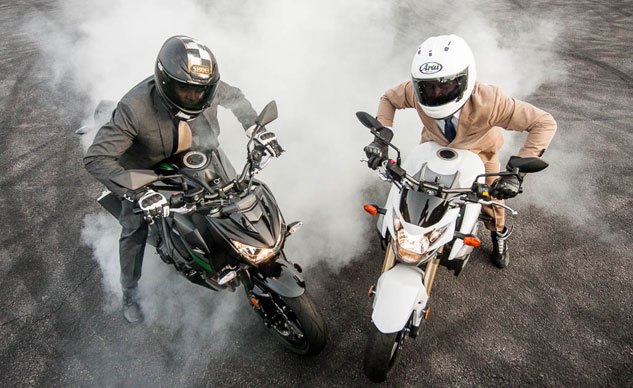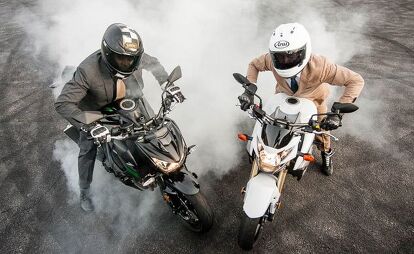Gentleman's Hooligan Comparo: 2016 Kawasaki Z800 ABS Vs. 2016 Suzuki GSX-S750

Brothers from another mother
Us MOrons enjoy the luxury of working from home offices, but imagine an alternate world where we actually had an office to go to everyday. Clearly, this scenario won’t be hard for many of you to imagine as it’s your reality. And if you’re also the type to take the long way home after clocking out, followed by a lengthier ride come the weekend, you’re the type of rider Kawasaki and Suzuki are reaching for with the Z800 ABS and GSX-S750 – unless you live in California. Neither bike is currently being offered for sale in the People’s Republic. Intended for the sportbike rider who may be more, ah, mature these days with things adults call, um, responsibilities, the two still offer middleweight performance without the supersport ergonomic commitment. They are also more affordable, at $7,999 for the Suzuki and $8,399 for the Kawi.
With the commuter/weekend warrior in mind, resident shark diving editor Tom Roderick and I set out to experience what life is like for the rest of you, incorporating freeway stints and city riding to mimic the daily grind, while playing in the local twisties to simulate your escape come the weekend.
Nine To Five
Once underway, the Zed emits just a touch more vibration than the Suzuki, especially at 6000 rpm, but both bikes are surprisingly smooth overall. The Kawasaki, and its 57cc displacement advantage (806cc vs. 749cc) makes more power (103.2 hp vs 98.6 hp), but from the saddle this advantage is barely noticeable when riding both bikes back-to-back. The Suzuki’s massive 70-pound weight advantage (436 lbs. vs. 506 lbs., ready-to-ride) gives it a better power-to-weight ratio (4.4 pounds per hp, vs. 4.9 pounds per hp for the Z) and nearly erases this power deficit.
Perched atop the Zed, the 800 rider has a commanding view of the road ahead, but it doesn’t take long before the board-like seat starts getting uncomfortable, bordering on painful – a major turnoff. Meanwhile, the Suzuki rider settles “into” the Gixxus, a trait common among Suzukis. At 5-foot, 11-inches, Tom notes a slightly more relaxed knee bend on the Suzuki compared to the Kawi, but the biggest difference between the two is the amount of padding in the Suzuki’s seat. “The Suzuki’s seat is the right combination of support and comfort,” Tom says.
Both motorcycles are well suited to the task of lane splitting; neither sets of mirrors extend too far out (both give decent view behind once you tuck your elbows in), and their minimal bodywork helps those with less spatial awareness to judge whether they can fit in a gap or not.
In The Hills
When it comes time to stretch the legs of our respective steeds, the Kawi’s power advantage is noticeable, but the Suzuki, and its considerable weight advantage, is never far behind. The Gix’s hiccup is a gearbox slightly less precise than the Zed’s, resulting in a false neutral here and there. I prefer the 750’s gauge cluster, which includes a gear-position indicator residing next to its analog tach, which is easy to read at a glance. However T-Rod favors the modern looking all-digital gauge cluster of the Z800, though it’s void of a GPI. “It looks like something built from this decade,” says Tom of the Kawi’s gauges, “unlike the the dated gauges of the Gixxus.”
When setting a quick pace on a curvy road, not much separates either bike. Ample leverage is provided by both sets of bars, but the Gixxus wins out by virtue of its lighter weight, making it less of a strain to pitch the bike from side to side. The Z800 can keep up, but its rider has to work just that little bit harder to hustle its 506 pounds around.
Preload adjustability is the only suspension adjustment on the Suzuki. It leans slightly toward commuter comfort but provides the firmness needed for spirited riding, despite bottoming too quickly over sharp bumps. The Kawi’s suspenders aren’t much better, both ends being adjustable for spring preload and rebound damping, but it feels firmer and better suited for quick riding. Both bikes will get unsettled, however, if trying to navigate rough patches of road while carrying decent lean angle. It’s here that the lower-spec suspension components of both bikes reveal their weakness. Tom sums up the suspenders on both bikes with one word: “sufficient,” but the Kawi gets the slightest of nods in the suspension category.
Neither bike comes equipped with radial brakes, but the Z800, and its petal discs, has a firmer lever and stronger initial bite, which we both prefer. In the Suzuki’s defense, it might be just a brake pad change away from being right there. However, the Kawi’s biggest advantage is its standard ABS, something the Gixxus lacks. The benefit isn’t so dramatic in ideal weather, but the peace of mind it provides when the morning dew blankets the roads (or any other time conditions are compromised) “negates the Suzuki’s lesser price tag,” says Tom.
From a performance perspective, we both are amazed at how similar these two are. Both are Japanese inline-Fours with similar seating positions that sound virtually identical to each other. Going, stopping and turning proved very similar as well. Even fuel mileage is close; we averaged 40.4 mpg with the Kawi, 41.7 mpg the Suzuki. “If this were a blind taste test,” Tom says, “you’d be hard-pressed fingering which bike you had just ridden. They’re that similar.”
Best of Both Worlds
The decider, then, comes down to the details. The Suzuki wins on price and has a much comfier seat. But we both agree the Z800 is a better looking bike, and Tom, being the outspoken type that he is, takes it a step further.
“Sitting next to the tastefully constructed Kawasaki, the Gixxus oozes bargain-bin architecture, whereas Kawasaki should be commended for not only engineering a good-looking motorcycle but also for ingeniously disguising its bargain-bin bits and pieces. Just look at the exposed exhaust on the Suzuki, with its ugly O2 sensor and exhaust valve where everyone can see, compared to the Kawasaki’s nicely stylized exhaust that covers any inherent ugliness.”
What’s important to you? If comfort and the impact on your wallet is top priority, the Suzuki will get the job done. The Kawasaki is the better looking of the two and has ABS. Deal closed. All we’d do is comb the aftermarket for a better seat and call it a day. “Just go buy the Kawasaki,” says Tom. “You’ll be glad you did.”
2016 Kawasaki Z800
+ Highs
- Good looks
- ABS
- Dyno chart winner
– Sighs
- She’s a porker
- Uncomfortable seat
- You can’t have it, California
2016 Suzuki GSX-750
+ Highs
- Under 8 grand
- Plush seat
- Light makes right
– Sighs
- Could use toothier brake pads
- Looks dated
- You can’t have it, California
Gentleman’s Hooligan Comparo Scorecard | |||
|---|---|---|---|
| Category | Kawasaki Z800 | Suzuki GSX-S750 | |
| Price | 95.3% | 100% | |
| Weight | 86.2% | 100% | |
| lb/hp | 89.8% | 100% | |
| lb/lb-ft | 91.2% | 100% | |
| Total Objective Scores | 90.6% | 100% | |
| Engine | 91.3% | 91.3% | |
| Transmission/Clutch | 83.8% | 80.0% | |
| Handling | 82.5% | 83.8% | |
| Brakes | 82.5% | 77.5% | |
| Suspension | 82.5% | 81.3% | |
| Technologies | 76.3% | 67.5% | |
| Instruments | 80.0% | 80.0% | |
| Ergonomics/Comfort | 80.0% | 85.0% | |
| Quality, Fit & Finish | 87.5% | 80.0% | |
| Cool Factor | 88.8% | 75.0% | |
| Grin Factor | 80.0% | 80.0% | |
| Tom’s Subjective Scores | 85.6% | 80.2% | |
| Troy’s Subjective Scores | 82.1% | 81.9% | |
| Overall Score | 85.2% | 84.8% | |
Gentleman’s Hooligan Comparo Specifications | ||
|---|---|---|
| Kawasaki Z800 ABS | Suzuki GSX-S750 | |
| MSRP | $8,399.00 | $7,999.00 |
| Engine Engine | 4-stroke, liquid-cooled, 4-cylinder | 4-stroke, liquid-cooled, 4-cylinder |
| Displacement | 806cc | 749cc |
| Fuel System | EFI | EFI |
| Valve Train | DOHC, four valves per cylinder | DOHC, four valves per cylinder |
| Horsepower | 103.2 @ 10,100 rpm | 98.6 hp @ 10,000 rpm |
| Torque | 58.1 lb-ft @ 7800 rpm | 54.9 lb-ft @ 8900 |
| lb/hp | 4.90 | 4.42 |
| lb/torque | 8.71 | 7.94 |
| Transmission | 6-Speed | 6-Speed |
| Final Drive | Chain | Chain |
| Front Suspension | 41mm inverted fork with rebound damping and spring preload adjustability. 4.7-in travel | 41mm inverted KYB telescopic fork, preload adjustable |
| Rear Suspension | monoshock with rebound and spring preload adjustability. 5.4-in travel | Link-type monoshock, 7-position preload adjustable |
| Front Brake | Dual 277mm petal-type rotors, 4-piston calipers, ABS | Dual 310mm discs, 2-piston calipers |
| Rear Brake | Single 216mm petal-type rotor, single-piston caliper, ABS | Single 240mm disc, 1-piston caliper |
| Front Tire | 120/70-17 | 120/70-17 |
| Rear Tire | 180/55-17 | 180/55-17 |
| Rake/Trail | 24.0º/3.9 in | 25.0º/4.1 in |
| Wheelbase | 56.9 in | 57.1 in |
| Wheelbase | 56.9 in | 57.1 in |
| Seat Height | 32.8 in | 32.1 in |
| Measured Weight | 506 lbs | 436 lbs |
| Fuel Capacity | 4.5 gal | 4.6 gal |
| Tested Fuel Economy | 40.4 mpg | 41.7 mpg |
| Available Colors | Metallic Spark Black/Flat Ebony | Pearl Glacier White |
| Warranty | 12-month limited warranty | 12 month unlimited mileage limited warranty. |

Troy's been riding motorcycles and writing about them since 2006, getting his start at Rider Magazine. From there, he moved to Sport Rider Magazine before finally landing at Motorcycle.com in 2011. A lifelong gearhead who didn't fully immerse himself in motorcycles until his teenage years, Troy's interests have always been in technology, performance, and going fast. Naturally, racing was the perfect avenue to combine all three. Troy has been racing nearly as long as he's been riding and has competed at the AMA national level. He's also won multiple club races throughout the country, culminating in a Utah Sport Bike Association championship in 2011. He has been invited as a guest instructor for the Yamaha Champions Riding School, and when he's not out riding, he's either wrenching on bikes or watching MotoGP.
More by Troy Siahaan


















































































































Comments
Join the conversation
Jeebus but that Kawasaki is fat.
As an owner of the Z800 AND the GSX "R" -750, I find the Kawi more than smooth and adequate in the engine and shifting. My GSX-R definitely has more kick to it and is sportier overall, but the Kawi handles extremely well and is no slouch. I personally couldn't be more pleased with both bikes. As for the GSXS-750...you can keep it...wouldn't even consider it for a second...just too blah blah blah - how could they make the GSXS1000 so great and the 750 so blah is hard to believe. As for weight, don't even notice on the Kawi - once it is rolling, no problem...it also handles much, much better than the FZ-09 I owned...but the FZ's motor was more exciting (when it wasn't sputtering, that is) - traded it on the GSX-R750 last year.